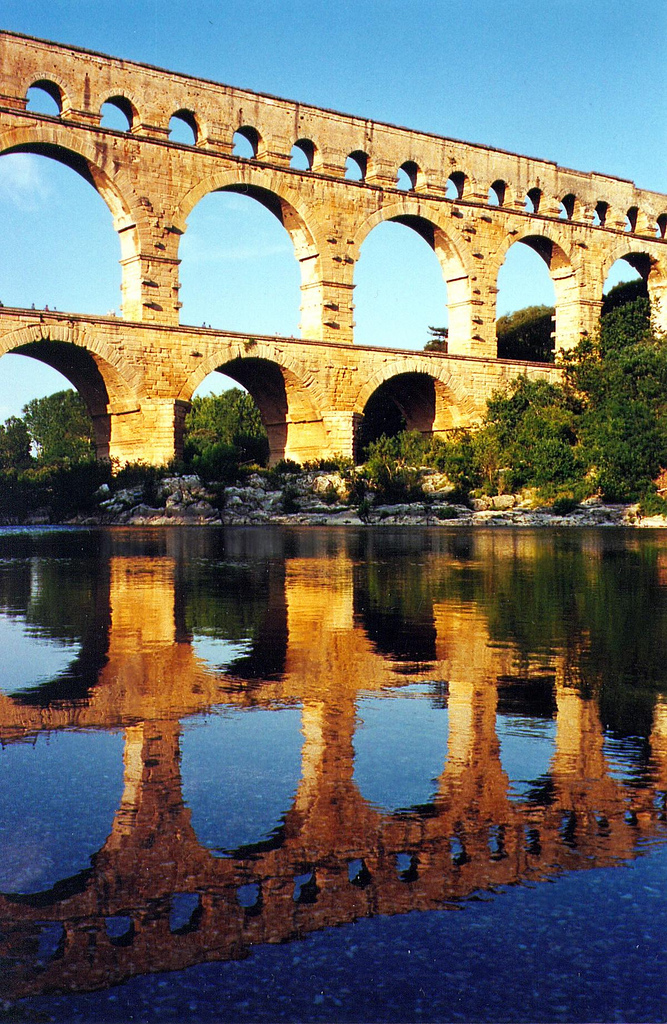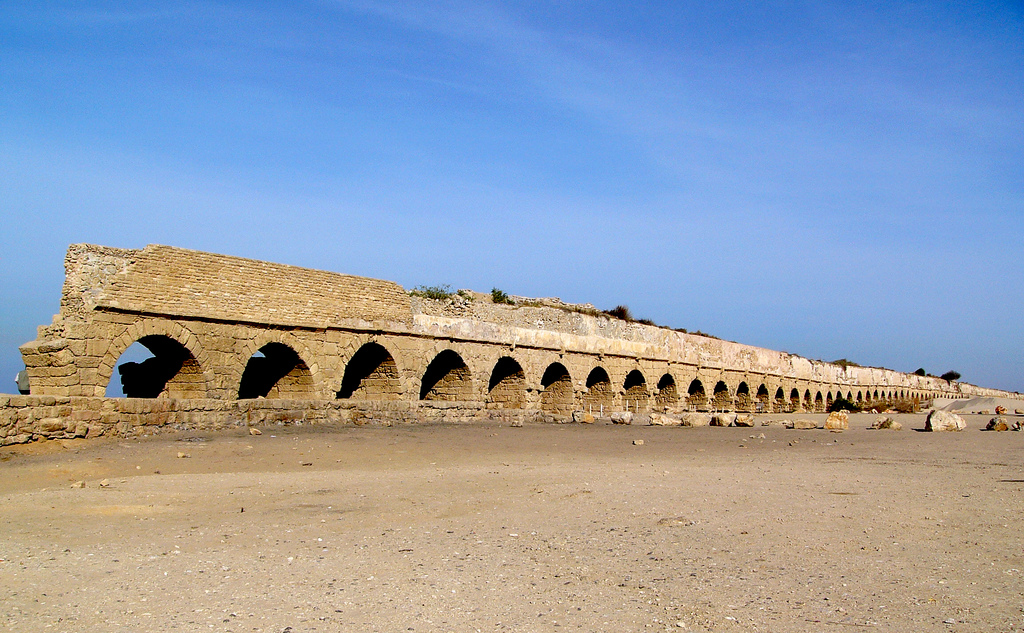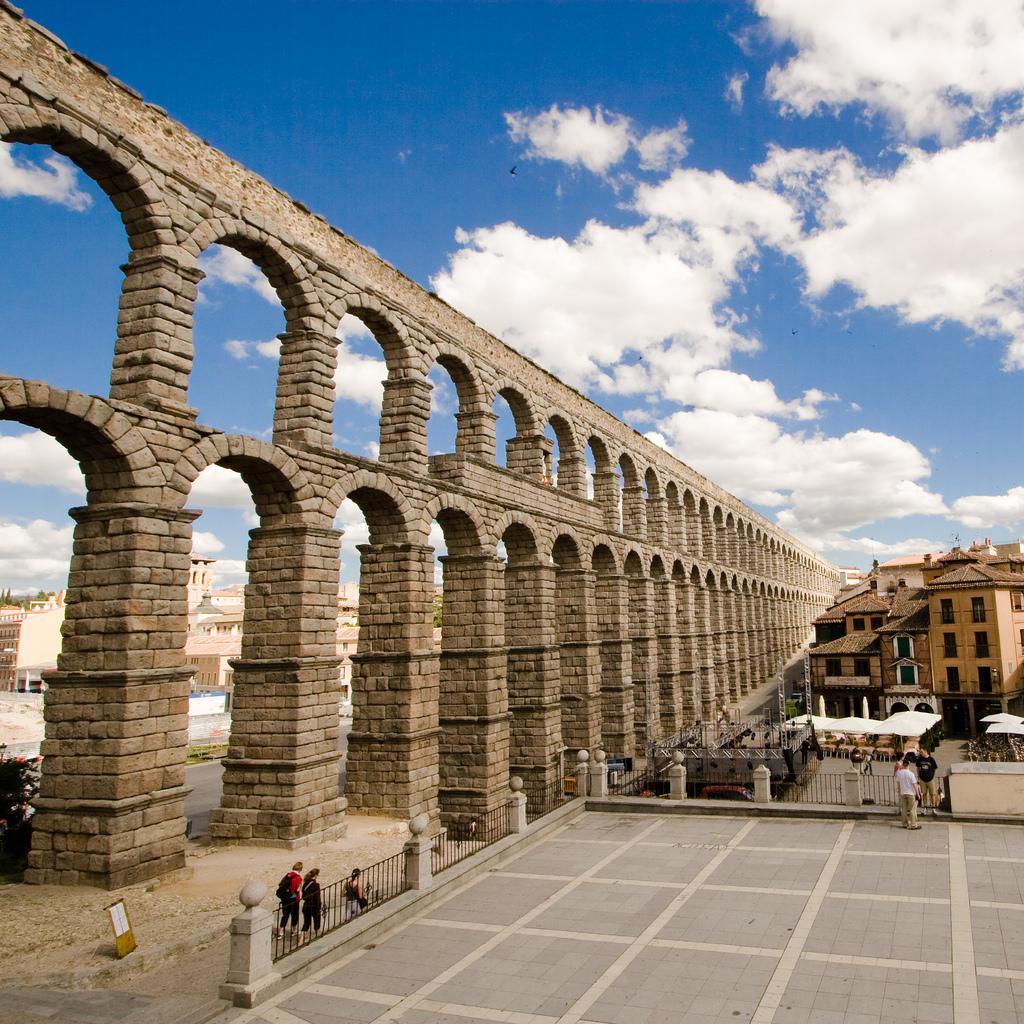Flying Rivers That Sustained An Unwieldy Empire: Roman Aqueducts, 312 BCE - CE 226
The River-Raisers
Aqueducts are “water ways” or “water bridges”—channels constructed to move water from some aqueous source to a place where the stuff of life is in demand. The idea of raising canals in order to control a steady supply of fresh water didn’t originate in Rome. Aqueducts were devised in the ancient Near East and India and used all over the world from an early date. In fact, raised, Roman-looking aqueducts were used as early as 700 BCE by the flourishing, piratical, and monumentalist Assyrians under Sennacherib. (His capital, Nineveh, probably had a population of around 150,000—a full two thousand years before the Dutch stole Manhattan from the Lenape Indians.)
But, like many other facets of military and municipal engineering (concrete, watermills, baths, arenas, dams, foundries, roads, mines, and siege weapons, to name a few), the pre-modern aqueduct was perfected in the city of Augustus and Marcus Aurelius.
 Again, it’s all about perspective: Moving a little drinking water from your river to your nearby city is one thing. Moving 5 million gallons a day to the city of Nemausus (Nimes) all the way from Uzès, 31 miles away, using clay pipes and masonry, is quite another. Yet this is exactly what one famous aqueduct accomplished—along which stands the elegantly arched Pont du Gard (Vers-Pont-du-Gard, Remoulins, in the Gard département), a 50-foot-high, 300-yard-long aqua-bridge—and could still accomplish, with a few stones moved back into place. The aqueduct looks more like a many-tiered stone road than plumbing. Across its whole run, it only drops down 17 meters as it moves speedily toward Nimes. This is a gradient of only 34 centimeters down per every 1 kilometer forward. Such a gradient allowed for water to move swiftly without clotting up or overflowing.
Again, it’s all about perspective: Moving a little drinking water from your river to your nearby city is one thing. Moving 5 million gallons a day to the city of Nemausus (Nimes) all the way from Uzès, 31 miles away, using clay pipes and masonry, is quite another. Yet this is exactly what one famous aqueduct accomplished—along which stands the elegantly arched Pont du Gard (Vers-Pont-du-Gard, Remoulins, in the Gard département), a 50-foot-high, 300-yard-long aqua-bridge—and could still accomplish, with a few stones moved back into place. The aqueduct looks more like a many-tiered stone road than plumbing. Across its whole run, it only drops down 17 meters as it moves speedily toward Nimes. This is a gradient of only 34 centimeters down per every 1 kilometer forward. Such a gradient allowed for water to move swiftly without clotting up or overflowing.
And that’s just the provinces. In bath- and fountain-crowded Rome itself, the ancient aqueducts, moving 300 million gallons a day, still figure into the water supply of the city today. Just about five hundred kilometers of aqueduct serve the great capital, a tenth of them visible above-ground. The mostly invisible plumbing helped in part with the whole “no germ theory” problem: A clean, largely underground water supply means fewer people die of dysentery and malaria (or “bad air,” spread by mosquitoes, which breed in stagnant water). But sometimes underground piping doesn’t cut it, when you need a certain pitch, or angle of water-flow, to move your aqua across many miles.
Water’s movement did more than sustain the thirsty. Water flowing through pipes moves waste out, which further reduces illness. And water running over mills turns them, making energy: At Barbegal in Provence, on the system supplying the town of Arles with water from the Alpilles mountains, a single aqueduct drove sixteen mills linked together in a series. Frequently aqueducts were used in mining, making them central to not only civic life, but to the commerce of the often stupendously money-stupid Romans as well.
Competing with the Pont du Gard system for most wondrous Roman water-system, the even longer Constantinople aqueduct represents, according to historian Cyril Mango, “one of the most outstanding surveying achievements of any pre-industrial society.” And who can blame Professor Mango (want: his name) for giving the Most Outstanding Olden Timey Construction award to an aqueduct?
After all, the Great Pyramids are great (somewhat tautologically), but they don’t do anything, post-pharaoh. The Pharos and Great Wall have functions, but their functions are out-of-date in an age of radar and missile-defense systems. Yet every city needs water.

How You Make A River Fly
First you have to know the lay of the land. To figure this out, the Romans invented complicated surveying instruments including the chorobates, the groma, and the dioptra. (Bonus points for the names.)
They also figured out how to use gravity-pressurized pipes (inverted siphons) to force water uphill, giving them more options as to where to build aqueducts. And they tested that water wasn’t toxic with lead (hence clay pipes), though no doubt lead was still a problem, especially for fetuses and young children.
But to really make a system of long, elegant, efficient aqueducts work, you need more than science. You need an empire, and the Iron-Age imperial equivalent of a preventative maintenance crew working for the New York City Department of Environmental Protection. Since aqueducts were subject to periodic breaches and blockages due to debris, as well as the buildup of natural chemicals such as calcium carbonate, they had to be inspected and cleaned. Miles and miles of aqueduct, serving the vital interests of a million people in the capital alone, had to be patrolled. This meant training and keeping an eye on a small army of inspectors (often members of the army, since martial and civic roles could be tangled up together).
Imagine being an aqueduct inspector, a general like Frontinus, responsible for those 300 million gallons. Frontinus did the math and found out more water was coming into Rome via the aqueducts than was available to the people. Upon closer inspection, he found people had inserted illegal pipes into the water channels to divert the flow, and he had to lay the civil engineering smack-down to fix the problem. He wrote to Trajanus about it in De aquaeductu, which must have been as gripping a tell-all in its day as any politician’s aide’s memoir is today. (HEADLINE: ROMAN WATER STOLEN BY ROMANS. EMPEROR PISSED.)
Keep It Flying
Or imagine working for a backwater governor, being sent to walk the Pont Du Gard and pull up drowned birds and scrub off hunks of calcium. Yours would have been nasty work, but you would have been keeping fit the arteries of a vast empire, one beyond your comprehension. After all, you had no Google Maps. You worked in part for a military dole of salt and a civil dole of grain from which your wife or servants could make bread. You drank watered down, oily white wine, and you didn’t bathe much. Water was life. Water was the flooding rain, withheld in the dry summers, and the punishing sea. The water of the aqueducts was the water of the fountains, the baths. It was the water of the people, the blood of the city and its extension into the harsh, uncivilized world.
You stood on the Pont Du Gard, high above the Province (southern France), and you thought of perhaps the most wondrous aspect of the system of water—stranger even than its constancy, its reliable provisioning of the people with life: The Pont Du Guard probably took about three years to build. Not generations, not decades. It was not a monument, even its heyday. The Pont and other huge chunks of the aqueducts were functional aspects of a system that arose, complexly, out of need. Sure, big-shots got paid making the thing. Little guys got jobs or were squashed by falling masonry. But the work got done. The gallons flowed. And you, humble gutter-sweeper, marveled that in so short a time such as thing grew on the back of the vast earth, like the ribs of a giant picked clean by Olympian condors.
(And then, presumably, you got boxed on the ears for daydreaming again by your superior. You kept moving. You cleaned, and the water soaked your leather boots.)
Waterfall, Crescendo, & Today’s Wonder Drinkers
 As the empire fell, however, so did the aqueducts. Enemies destroyed them, and the maintenance system so on-point under Frontinus and the Good Emperors became a joke, then a memory under the despots of the early Christian era. In medieval times, Rome itself housed only a few dozen-thousand people, and the aqueducts that cropped up were tiny, local affairs, borrowing Roman ideas about engineering but never again achieving complex, long systems such as those of Pont Du Gard or Constantinople.
As the empire fell, however, so did the aqueducts. Enemies destroyed them, and the maintenance system so on-point under Frontinus and the Good Emperors became a joke, then a memory under the despots of the early Christian era. In medieval times, Rome itself housed only a few dozen-thousand people, and the aqueducts that cropped up were tiny, local affairs, borrowing Roman ideas about engineering but never again achieving complex, long systems such as those of Pont Du Gard or Constantinople.
The Pont Du Gard was used to teach journeymen masons their craft: The bridge-arch-waterway employs no mortar, no fudging of math or half-assing of craft. It conforms to the classical, functional, elegant, form-married-happily-to-content-with-kids ideal that would inspire the Renaissance, over fourteen hundred years after the Pont was raised in 19 BCE.
Yet civil life is still wondrous. Living in a city, taking a bath, and knowing your waste is already moving far away from your house is, altogether, a feat of engineering, in any era. By it, the everyday is transformed into what in literature is called the fantastic-uncanny—what we doubt, believing to be fantasy, until it is revealed as fact.
We never left the wonder of civil life (and civil water supply) behind; we have refined that life, and thus refined our sense of wonder. While arched aqueducts do not grow any more along the highways, we do have the G-Cans project in Tokyo, a massive underground waterway built to protect Tokyo from flooding during the monsoons. And we don’t have to look into the future of Tokyo’s drainage to find modern aqueducts.
Here in New York—a city conceived by the Founding Fathers as the New Rome, a city eager in the Tammany Hall days to prove that it was—we have a not-too-shabby water system sporting our own great aqueducts, including the Old Croton, New Croton, and Catskill. The last supplies us with 40% of our water. But the first was, well, the first, and in many ways, it’s still an amazing tunnel.
The Old Croton Aqueduct, built between 1837 and 1842, brought water by gravity alone 41 miles from the Croton River into a reservoir near today’s Bryant Park. For a city choking on its own rapid growth, Old Croton was a godsend, and yet it wasn’t enough. It improved hygiene, reduced the poor’s daily reliance on hard spirits (which are always potable—not to mention delicious), and helped spread the familiar German cockroach (or at least, a general fear of it). But within a few decades, it was obvious another aqueduct would be needed to keep up with the expanding population of the city.
In 1890, the New Croton Aqueduct went online, carrying three times what Old Croton could. Old Croton soldiered on until 1940, when it was drained and filled to created Central Park’s Great Lawn.
So what’s the first great aqueduct of the New Rome up to today?
Old Croton is New York City’s dark, hollow, supernumerary throat. It’s illegal to venture down, but intrepid graf artists, urban explorers, thrillseekers, molemen, and homeless surely do. Unlike the Pont Du Gard, which the French keep in tip-top shape and use to attract tourism geld, Old Croton is unloved and unknown. It is like a sad old country-music star eternally about to die of alcoholism, yet never dead.
I’m not saying we should open it up and sell tickets, but I do wonder how the shut-down aqueduct could serve the city as it stands (and leans, and stumbles upward) today, as well as the city of tomorrow.
“All water has perfect memory and is forever trying to get back where it was,” said Toni Morrison. If only cities remembered a little longer, a little better, how their water came down from the wild peaks. If only, like the water remembering the simplicity of ice, rain, and sea, the stone and metal and brick of the city preserved its history (the simplicity of people, builders, maintenance crews, molemen) and let an occasional light shine down its thirsty throat.






Follow us on Twitter to get the latest on the world's hidden wonders.
Like us on Facebook to get the latest on the world's hidden wonders.
Follow us on Twitter Like us on Facebook